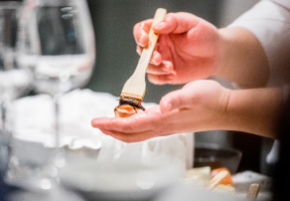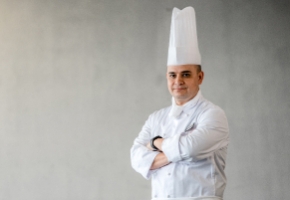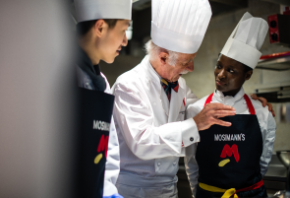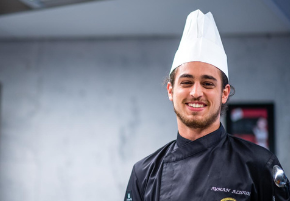- About
- Programs
- Campus Life
- Career Services
- Admissions
- News & Events
- Alumni
Cake Decorating for Beginners: Tools and Techniques
Discover cake decorating tools, beginner techniques, and pro tips. Learn how to decorate cakes beautifully and explore career options in pastry arts.
Key Takeaways
- With more than 75% of consumers seeking personalized cakes for special occasions, there’s a rising demand for custom designs, opening exciting opportunities for decorators.
- Mastering the basics like crumb coating, piping, and fondant application is essential for creating clean, stable, and visually appealing cakes.
- The right tools and techniques make a big difference, and you don’t need advanced equipment to start decorating.
At every celebration, from birthdays to weddings, there’s always that one sweet centerpiece stealing the show: the cake. Before the first bite, however, it’s the look that draws people in. Swirls of frosting, delicate flowers, and smooth fondant finishes—this is where cake decorating works its magic.
Cake decorating blends skill with imagination, turning a plain dessert into something unforgettable. It is the creative process of adding visual appeal to cakes through frosting, fondant, piping, and other finishing touches.
Anyone can pick up and grow into cake decorating with a bit of passion and the right training. At Culinary Arts Academy Switzerland (CAAS), the Swiss Diploma in Pastry Arts program helps aspiring decorators master these techniques and bring their edible art to life.
What You Need to Start Decorating Cakes
Before you start decorating, make sure your cake is fully baked, cooled, and leveled. This prevents melting, sliding, or uneven finishes. A solid base sets you up for a cleaner, more polished design. Think of it as preparing your canvas before painting.
Having the right tools is also essential. Cake decorating becomes much more enjoyable when you’re working with tools that support your creativity. Whether you want to make simple swirls or sculpt flowers, having the essentials in place gives you a strong start.
Here are some must-have tools for beginners:
- Offset spatula for spreading frosting smoothly
- A cake turntable to easily rotate your cake as you decorate
- Piping bags and tips for adding details, borders, and lettering
- Bench scraper for smoothing sides
- A cake leveler or a serrated knife to create even layers
- Couplers to quickly change piping tips
As for ingredients, decorators often start with:
- Buttercream for spreading and piping
- Fondant for covering cakes or shaping decorations
- Gel food coloring to add custom colors
- Simple syrup to keep layers moist
Basic Cake Decorating Techniques for Beginners
If you’re planning on starting a baking business or just want to get into cake decorating, mastering a few basic techniques is important before exploring intricate designs. These beginner-friendly skills lay the groundwork for clean, polished cakes and help build confidence in every step.
From smoothing frosting to simple piping, these methods are used by home bakers and professionals alike. They may look impressive, but they rely more on practice than fancy equipment. With a few simple tools and a steady hand, anyone can start decorating cakes that look as good as they taste.
Crumb coating and layer smoothing
Start Your Culinary Journey
Learn the art of cooking in a world-class environment
Crumb coating is the thin layer of frosting that locks in loose crumbs before the final coat is applied. This step helps create a clean, smooth surface, especially when working with light-colored frosting or fondant. Skipping this layer can lead to visible crumbs in your finished design.
Start by spreading a light layer of frosting over the entire cake, just enough to cover the crumbs without overloading. Once applied, let the cake chill in the refrigerator for 15 to 30 minutes. This sets the coating and makes the final frosting layer easier to apply.
For smooth results, use an offset spatula to apply frosting and a cake scraper to even out the sides. Rotate the cake on a turntable as you go for more control. With some patience, you’ll get smooth, clean layers that create the perfect foundation for more detailed decorating.
Piping skills
Piping adds detail, texture, and flair to cakes using frosting and different-shaped tips. For beginners, a few basic tips can go a long way:
- Round tips are great for writing, dots, and outlines.
- Star tips create swirls, rosettes, and borders.
- Leaf tips shape foliage and floral accents.
Consistent pressure is key when piping. Practice on parchment paper before decorating a cake to get a feel for the motion and flow. It helps you learn how to control the shape and size of each design.
Start with patterns like shells, rosettes, zigzags, and simple borders. These build muscle memory and improve your control. Use a turntable to guide your movement and keep designs even.
Fondant basics
Fondant gives cakes a smooth, polished finish and opens up possibilities for custom shapes and textures. There are two common types: rolled fondant, used to cover cakes, and modeling fondant, which holds its shape better for making flowers, bows, or figures.
To cover a cake with rolled fondant, first dust your work surface with cornstarch or powdered sugar. Roll the fondant into an even sheet, approximately 1/8 inch thick, then gently lift and drape it over the cake, smoothing the top first and then working your way down the sides.
Use a fondant smoother or your hands to press out any air bubbles and flatten edges. Trim the base with a sharp knife or pizza cutter afterwards. To avoid tears or cracks, don’t stretch the fondant, and make sure the frosting underneath is chilled but not too firm.
Edible decorations
Edible decorations are a simple way to add charm and texture to your cakes without needing advanced skills. For beginners, some of the easiest and most effective choices include:
- Sprinkles, which add color and fun
- Chocolate shards, for texture and contrast
- Fresh fruit, offering a natural, vibrant touch
These decorations are playful, quick to use, and add an extra layer of creativity to your designs.
When applying decorations, timing matters. Add sprinkles while the frosting is still soft so they stick well. For chocolate or fruit, gently press them in place after the final layer of frosting is smoothed. Keep placement balanced and intentional.
Try clustering decorations around the edges or in one section of the cake to create visual focus. Less is often more. A few well-placed accents can look much more polished than covering the whole surface.
Working with color
Color brings personality to your cakes, but it takes a bit of care to use it well. Gel and powder food coloring are great choices because they give rich color without changing the texture of your frosting or fondant. With a bit of practice, you'll develop an eye for color that brings your cake designs to life.
Start with small amounts and build gradually. This helps prevent oversaturation, which can lead to strange shades or a bitter aftertaste. For smoother blends, mix colors ahead of time in a small bowl before adding them to your main batch.
You can create soft pastels with a tiny dab of color or go bold by layering in more. Try experimenting with color palettes that match your theme or season. Warm tones like peach and gold work well for summer celebrations. Cool blues and whites feel fresh and clean for winter cakes.
How to Decorate a Simple Layer Cake
Decorating a layer cake becomes easier once you understand the basic steps. A two-layer cake is a great starting point for practicing techniques and building your skills. Practice is the best way to improve. Each cake you decorate builds your confidence and helps you refine your technique over time.
Here’s a simple step-by-step guide to get started:
- Bake and cool your cakes completely before decorating
- Level the cake layers using a serrated knife or cake leveler so they sit flat
- Stack the first layer on a cake board or stand, and spread frosting on top. You could add a bit of frosting on the cake board as well to avoid any unwanted movement.
- Place the second layer on top, aligning the edges
- Apply a crumb coat, a thin layer of frosting that locks in crumbs
- Chill the cake for about 20 minutes so the crumb coat sets
- Add the final layer of frosting, smoothing the top and sides with a spatula or scraper
- Decorate with simple touches, like piped borders, sprinkles, or fruit
Cake Decorating Ideas for Different Occasions
Every occasion offers a chance to get creative with your cake decorating. A few thoughtful touches can transform a basic cake into something that fits the moment perfectly.
Every cake can be personalized with color choices, edible toppers, and simple patterns. Keep it beginner-friendly by starting with clean lines and gradually layering in details as your skills grow. You don’t need advanced skills to make cakes that feel festive and personal, just a little planning and imagination.
- For birthdays, try bright colors, piped borders, and number or name toppers. Sprinkles, candy, and edible glitter add a fun touch. Keep things playful with balloons, animals, or simple cartoon themes.
- Weddings often call for soft colors like ivory, blush, or sage green. Smooth buttercream, fresh flowers, and gold accents create an elegant look. A single-tier cake with floral piping can be just as charming as a large one.
- During holidays, let seasonal colors inspire your designs. Red and green work well for winter celebrations, while orange and brown suit autumn gatherings. Add mini pumpkins, snowflakes, or candy canes for a festive finish.
- For baby showers or anniversaries, go with soft pastels and gentle textures like rosettes or ruffles.
Tips for Beautiful and Professional-Looking Cakes
Once your cake is stacked and decorated, a few thoughtful details can take it to the next level. These tips focus on refinement and presentation, helping your cakes look just as impressive as they are delicious.
- Choose a sturdy cake board that’s slightly larger than the cake. It frames the design and makes it easier to transport.
- Use a damp paper towel to clean around the base once decorating is done. This keeps the edges neat and free of smudges.
- Stick to a design plan. Whether it’s symmetrical piping or scattered toppings, consistency makes a big difference in appearance.
- Add height variation by layering toppings or using a small topper. Even a single flower or fruit piece can create a focal point.
- Store decorated cakes in a cool place, ideally in the fridge if the frosting allows. Let it come to room temperature before serving for the best texture.
Extra tip: Make sure everything is centered and evenly spaced. Step back now and then while decorating to check balance and symmetry. Clean lines, clear intention, and careful storage all play a part in creating cakes that feel both artistic and professionally finished.
Career Opportunities in Cake Decorating
Career opportunities in cake decorating span a wide and exciting range, from boutique roles to entrepreneurial ventures. The market for custom cakes is growing rapidly, as more and more individuals seek personalized food experiences. Over 75% of consumers are willing to invest in personalized cakes for special occasions, indicating that opportunities in cake decorating are likely to continue expanding significantly.
Some of the most common bakeries and baker-chef roles you can explore in this area are:
- Pastry chef in restaurants or hotels, specializing in plated desserts and decorative elements.
- Wedding cake designer, crafting elaborate tiered cakes for high-end events.
- Bakery owner or custom cake specialist, offering personalized cakes to individual clients.
Education plays a key role in building both credibility and confidence. Programs like the Swiss Diploma in Pastry Arts at CAAS provide practical training in cake structure, advanced decorating techniques, and bakery operations. The school’s faculty includes professionals like Chef Yann Muriset, who brings decades of global pastry experience to the classroom. He combines his deep technical knowledge with a passion for teaching, encouraging students to develop discipline, patience, and creativity—traits that are essential for success in the field.
Leandra, a graduate of the Pastry Arts program at CAAS, is a great example of where cake-decorating training can lead. After switching careers from sales, she built a new path in pastry, developing both technical and creative skills that now support her work in artistic dessert creation. Talking about her experience at CAAS, she noted,
I learned everything from scratch, which is exactly what I needed because I didn’t have any previous knowledge of pastry. I learned everything from how to make mille feuille and laminate croissant dough to tempering chocolate and working with cocoa butter to make truffles and praline. We were taught how to make traditional baked cakes as well as modern mousse cakes, playing with different layers.
Many CAAS graduates go on to make a name for themselves. Danna Vu, for example, won the Culinary World Cup and now works as a pastry chef at Svedjan Bageri in Stockholm, Sweden. Her success reflects how formal training in pastry arts can lead to international opportunities and high-profile achievements.
Larger retailers also recognize the value of skilled decorators. For example, Walmart staff earn an average of $19.25/hour, with experienced decorators reaching $24+/hour, reflecting the value of cake‑decorating talent. Cake decorators are actually the highest-paid professionals in a typical U.S. Walmart after managers.
Turning to social media is another powerful avenue to explore, as it boosts visibility and opportunity like no other. Platforms like Instagram and TikTok fuel trends and help decorators build brand awareness, making visually driven marketing an essential skill.
The Start of Something Sweet
Cake decorating blends creativity, precision, and a touch of artistry, making it both a fun hobby and a valuable skill. From learning essential tools and techniques to exploring designs for special occasions, there’s so much to discover. Starting with the basics builds the confidence needed to create beautiful, professional-looking cakes.
For those who feel inspired to take it further, consistent practice is key. Most importantly, however, formal training can make all the difference. Check out our programs at CAAS for the perfect environment to grow, learn, and shine.
Frequently Asked Questions
How to start as a cake decorator?
Begin with basic tools, learn simple techniques like piping and crumb coating, and practice regularly to build confidence and skill.
What are some easy cake recipes suitable for beginners to decorate?
Vanilla sponge, chocolate cake, and butter cake are beginner-friendly options with sturdy textures ideal for decorating.
Can I decorate a cake the night before serving?
Yes, as long as the cake is stored properly in a cool place or refrigerator and is fresh and stable.
Interested in studying at CAAS? Download our brochure to learn about our programs!


























